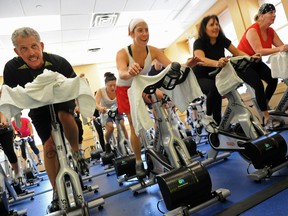Postmedia may earn an affiliate commission from purchases made through our links on this page.
Fitness
Glute workout: 5 best equipment and machines to tone your butt at home

A well-toned, sculpted posture not only enhances your appearance but also plays a crucial role in maintaining overall strength and stability. While there are various exercises that can target the glute muscles, incorporating some specialized equipment and machines into your at-home workout routine can take your glute workout to the next level. We looked up for a few best glute exercise equipment and machines to help you achieve firmer and a more toned butt from the comfort of your own home.
Glute equipment and machine for butt workout
These are 5 glute exercise equipment and machines that can help tone your buttocks:
1. Ankle resistance bands
Ankle resistance bands are versatile and inexpensive tools that can significantly intensify your glute workouts. These bands come in various resistance levels, allowing you to adjust the difficulty according to your fitness level. The bands can be easily wrapped around your ankles to add resistance during exercises like kickbacks, leg lifts, glute bridges, lateral walks, and hip training. By providing constant tension, ankle resistance bands engage the glute muscles throughout the entire range of motion, helping you build endurance and tone your glutes and legs.
2. Stepper machine
Stepper machines, also known as stair steppers, are excellent for targeting the glutes while providing a low-impact cardio workout. These machines simulate the motion of climbing stairs, activating the gluteal muscles with each step. Stepper machines come in different types, such as manual steppers and motorized ones with adjustable resistance levels. For a glute workout, choose one with resistance bands because they help to target and tone your calves, glutes, and hip flexors. Moreover, using a stepper machine regularly can help firm up the glutes, burn calories, and improve cardiovascular health, enabling a full-body workout.
3. Pilates bar kit
Pilates bar kits are portable and versatile pieces of equipment that can be easily set up at home. These kits typically consist of a lightweight bar with resistance bands attached to each end. By using it in conjunction with hip resistance bands, you can work on various muscle groups, including your glutes, arms, legs, and abdomen. The Pilates bar kit is ideal for performing exercises like squats, lunges, and leg presses, all of which contribute to shaping and toning the buttocks.
4. Weight lifting belt
While weight lifting belts are traditionally associated with lifting heavy weights, they can also be an effective tool for glute workouts. These belts provide support to your lower back, enabling you to lift heavier weights during exercises like deadlifts and squats without compromising your form. By engaging the glute muscles in these compound movements, you can achieve significant progress in glute strength and size.
5. Whole body workout machine
Whole-body workout machines, such as rowing machines and ellipticals, are fantastic options for engaging multiple muscle groups, including the glutes. Rowing machines require a powerful leg drive and hip extension, which heavily involve the glute muscles. Similarly, ellipticals provide a low-impact yet effective way to target the glutes, making them an ideal choice for individuals with joint issues. Incorporating these machines into your home gym setup can add diversity to your glute workouts and contribute to overall lower body strength.
When incorporating these equipment and machines into your workout routine, be sure to follow proper form and gradually increase the intensity as your strength and endurance improve. And do not forget to include a balanced mix of exercises to work various muscle groups and maintain overall fitness!
(Disclaimer: At Health Shots, we make a constant effort to break the clutter for our readers. All products listed are carefully curated by the editorial team but use your discretion and an expert’s opinion before using them. Their price and availability may differ from the time of publication. If you buy something using these links in the story, we may earn a commission.)

Fitness
Promoting Health, Fitness in Holtville — This is The Way – Calexico Chronicle

HOLTVILLE — In a scene of organized chaos, the Mandolorian led Holtville youths down East Sixth Street as they made their way to Finley Elementary School, walking and riding bikes, scooters and rollerblades to promote healthier habits.
National Bike and Roll to School Day is a nationwide event that schools can participate in anytime during the month of May, with the official day marked for May 8. Holtville chose Friday, May 3, where students and many adults wore their favorite “Star Wars” T-shirts, hats and Grogu gear to celebrate “Star Wars” Day (May the Fourth), which is always the town’s theme for the activity, a decision made years ago by the man beneath the Mandolarian’s helmet, Holtville Fire Chief Alex Silva.
“About five or six years ago, we noticed there was an actual ‘Ride Your Bike to School’ event and we wanted to join in on it,” Silva said, explaining more about the event’s origin.
“We started originally as walking to school only, and the original plan was to meet the deputies and the firefighters and it spread to this,” he said pointing around at all the childrens’ bikes.

Silva wore the custom-made Mandolorian helmet for his bike ride, a 3-D printed masterpiece crafted by his son, leaning into the fictional fun with the kids. “Since it’s in May, we decided to make it ‘Star Wars’-themed. I love ‘Star Wars,’” he explained, “So I said, let’s make it every year near May 4 for ‘May the Force be with you.’”
The Imperial County Sheriff Department was present to ensure safety of the large group, with deputies talking with students and providing assistance by blocking cross-street traffic during the ride. The rest of Silva’s fire crew supervised and gave kids high-fives of encouragement while the crowd made their way down the street. All the adults worked together, providing an epic way for the youths to start their Friday.
This is the Way
The morning began with a group warm up before the ride, with Silva leading the Emmett S. Finley Elementary School students. Backpacks and bikes were parked around the edge of the basketball court while students spread out ready to follow the Mandolorian (Silva) through some warm up moves before taking to the streets. Lined up by grade, the students gathered like a bunch of cute little ewoks, ready for action.


One parent and staff member at the elementary school, Linda Serrano, said, “I’ve been coming to Finley for 13 years and I’ve never made it to this, so I’m happy to be here.”
Serrano was standing outside the Ralph Samaha basketball court before the ride began, alongside other parents, siblings, and school staff, watching the kids stretch as a group before the ride began.
See also


“It teaches them — the parents and the kids — to do an activity together, and promotes exercise and learning some safety too,” Serrano explained, talking about the event.
The youths warmed up with some jumping jacks and full-body stretches, laughing along to various jokes Silva tossed their way. Marco Page, Finley Elementary’s principal, was stretching on the sidelines supporting the cause alongside his students and a couple other staff members.
After the event he commented briefly, saying, “It’s another health initiative, just to promote the students to be healthy.”
Page said the school advertised in the weeks leading up to Friday, handing out flyers to students and promoting the event on social media as well.


Fitness
Busting 5 common wellness myths

During one of my recent doom-scroll sessions on the ‘Gram, I came across a fitness influencer who sticks “yoga teacher & nutritionist” against her name, has 236,000 followers, and in one of her videos was claiming to teach us how to ‘naturally’ increase our height.
The first exercise to increase your height, according to the influencer, is three sets of hanging from a bar for 30 seconds. I have been a monkey all my life and hanging from a bar is something I started doing as a kid and, firmly in my 40s now, I still do it. Since forty years of hanging from a bar failed to do anything for my height, it got me thinking how much of such ‘fitfleuncer’ content is actually factual and scientific.
While I shall save the question of whether one should follow fitness, health, wellbeing, and nutrition advice from someone with vague credentials on a social media platform for another day, for now let’s explore how much water some popular health myths hold.
A spoon of ghee/butter in coffee is good for health:This is a topic of debate in the health and wellness world, says Shalini Garwin Bliss, executive dietician at Manipal Hospital in Gurugram. She notes that proponents of this argue that the healthy fats in ghee or butter can provide a slow-release source of energy and promote satiety. However, Chandni Haldurai, the head nutritionist at Cult Fit, warns against doing this, no matter how delicious it sounds.
“Coffee with ghee or butter may sound delicious, but it’s not always a good idea. Although these fats can give you a brief energy boost, their high-calorie content quickly adds up. This tendency may not be helpful for people seeking to control their cholesterol or weight,” says Haldurai. It’s crucial to remember that this extra fat contributes to increased calorie intake, potentially hindering weight management efforts, adds Bliss.
Apple cider vinegar is good, helps burn fat:This idea is big these days as not only influencers but gym trainers and coaches also support the idea of having daily doses of apple cider vinegar. While there are several potential health advantages of apple cider vinegar, including improved digestion and prevention of increases in blood sugar, it is not a miracle cure for weight gain, says Haldurai.
“There is no magic bullet for weight loss. Simply consuming apple cider vinegar daily is unlikely to lead to significant weight loss without complementary lifestyle changes like a balanced diet and exercise,” says Bliss.
A comprehensive strategy for weight management that incorporates nutrition, exercise, and lifestyle modifications is the only efficient way to achieve and maintain weight loss. Alas, it’s common to exaggerate claims of miracle weight loss without making the necessary efforts, say coaches and nutritionists.
Jaggery and demerara sugar are safe:Sugar is the top enemy of anyone even mildly invested in health. But many simply replace refined sugar in their diet with jaggery and demerara sugar. Next time you put that second spoon of jaggery or demerara sugar in your tea or coffee, you should remember that despite being less processed than refined sugar, both are still sugars and can have an impact on blood sugar levels.
“Due to their low processing and trace nutrients, they might be marginally preferable solutions, but people with prediabetes or diabetes shouldn’t choose them. Anyone ingesting these alternatives needs to practice moderation and keep an eye on their blood sugar levels,” warns Haldurai. Moderation is all sugar and sugar substitute intake is the key, warns Bliss.
Freshly squeezed and cold-pressed juices are healthy:It is indeed true that fruit juices that have been freshly squeezed or cold-pressed retain more nutrients than packaged juices. But all such juices have little to no fibre. Due to their high fibre content, which helps slow down the absorption of sugar, whole fruits provide the most advantages, says Haldurai. However, if you must have your fruits in liquid form, smoothies that are made with whole fruits, yoghurt, or vegetables are preferable, since they retain fibre and offer a more well-balanced vitamin profile.
Hanging leads to height gain:Saved the best for last. If only hanging from bars actually led to height gain, many of us would have been giants. There is no good evidence or study to support these claims, says Dr. (Prof.) Amite Pankaj Aggarwal, directorand head of the department for orthopaedics, Fortis Hospital, Shalimar Bagh in New Delhi.
“It’s amyth that certain exercises or stretching techniques, such as pull-ups and hanging from a rod, can make you grow taller,” says Aggarwal, dismissing the tall claim.
Height gain depends on a lot of factors, from one’s genetics to diet to muscle strength, explains Dr. Poonam Sidana, neonatologist and paediatrician, CK Birla Hospital, NewDelhi.“Those who go out and play sports such as basketball are more likely to grow stronger because they are actually running around and are able to use all their bigger muscles. So, it really is a combination of things and cannot be attributed to a single activity,” adds Sidana.
Shrenik Avlani is a writer and editor and the co-author of The Shivfit Way, a book on functional fitness.
Fitness
Fitness: Find right balance between pleasure and pain when you exercise

No matter who’s exercising, the closer the workout comes to requiring maximum effort the more unpleasant the exerciser feels.
Article content
For some people, exercise requires too much effort. Others believe it isn’t exercise unless their physical limits are being pushed. This love/hate relationship with effort often marks the dividing line between exercisers and non-exercisers. It’s also the theme of numerous studies exploring how effort can be manipulated to be less of an exercise deterrent.
Advertisement 2
Article content
No matter who’s exercising, the closer the workout comes to requiring maximum effort the more unpleasant the exerciser feels. Workouts that stay in a more moderate zone generally elicit more enjoyment, though the line between when a workout goes from feeling good to feeling uncomfortable varies considerably between individuals.
Article content
Some people maintain a level of intensity that never creeps into the zone where there’s more pain than pleasure. But most exercisers opt for a gradual rise in intensity until it takes effort to maintain the pace, then try keeping it there to the end of the workout.
Also popular is interval training where intensity peaks for short periods of time followed by equally short periods of recovery. This ebb-and-flow style of workout has been billed as more palatable for those who find it difficult to sustain longer bouts of constant effort, though the jury’s out as to whether steady state or interval training are more palatable for people trying to make exercise a habit.
The trouble is, when it comes to evaluating enjoyment during exercise, there’s a distinct difference in feedback depending on when the exerciser is polled. Remembered pleasure or displeasure is distinctly different from feelings elicited during a workout. The longer the gap between the end of the workout and when the exerciser reports their feelings, the more favourable they view the workout.
Advertisement 3
Article content
Still, no matter how much time modifies our feelings, some things we don’t forget. Studies suggest the more unpleasant the workout, the less likely we are to go back for more. There is a caveat, however. Researchers studying how enjoyment factors into exercise adherence have noted a difference between recreational exercisers and athletes. With goal-based athletes, bouts of extreme exertion are associated with accomplishment, which alters their outlook not just on the importance of enjoyment during a bout of exercise but also on how they rate enjoyment post-workout. With this crowd, the idea that exercise has to hurt to be beneficial is ingrained into their psyche.
For everyone else, the slope of exercise enjoyment within a single workout is worthy of study. Is there a way to manipulate the timing of pleasure so that we end workouts feeling on a high versus physically wrung out? And will that feeling of pleasure make the next workout less intimidating and therefore more likely to happen?
There’s some research suggesting that instead of focusing on increasing or maintaining intensity, a workout should end easier than it started. Others recommend easing into effort and finishing with purpose. Then there’s the pyramid format that starts off at a comfortable intensity, increases to maximum effort midway and ramps down again as the workout winds down. Each format has its pros and cons, with results inconclusive as to whether one design is more enjoyable than others.
Advertisement 4
Article content
Adding to the body of evidence is a recent study published in Psychology of Sport and Exercise reviewing what the researchers call the “slope of pleasure” and its effects on remembered pleasure, forecasted pleasure and enjoyment. The researchers from California State University in Bakersfield theorized that the optimal slope of pleasure occurred when exercisers experienced a gradual increase and then decrease in effort, versus an ascending (the workout gets harder, with peak effort occurring toward the end of the workout) or descending (the workout ramps up in intensity quickly then eases off to finish easier than it started) slope. The idea was to see whether a less intense start or finish was more enjoyable.
To make sure all workouts were similar in volume and overall intensity, they all started with a two-minute warmup followed by 30 minutes of continuous exercise and a 10-minute recovery. All protocols were matched in overall effort with about 20 minutes of exercise at a moderately hard intensity and 10 minutes at or around peak effort.
The ascending slope increased intensity by 2.5 per cent every two minutes while the descending workout decreased intensity by 2.5 per cent every two minutes. The ascending/descending protocol increased intensity by 2.5 per cent every two minutes, then at the midpoint started decreasing effort by 2.5 minutes. Enjoyment was polled before exercise, every five minutes during exercise and 10 minutes after exercise.
Advertisement 5
Article content
Only the ascending workout changed the level of enjoyment over the course of the workout with exercisers feeling worse when intensity continually increased. The other workouts, both of which featured a decrease in intensity, noted no change in enjoyment from the start to the end of the workout.
These results disproved the researchers’ hypotheses, who thought enjoyment would increase as intensity level dropped. It also differed from previous research reporting that a decrease in intensity resulted in greater exercise enjoyment, including greater remembered pleasure, than workouts that got increasingly harder.
But the takeaway for the average exerciser isn’t that the results weren’t as forecasted. Instead, the idea that intensity can be manipulated to provide a more enjoyable workout is worthy of notice.
Also important to highlight is that individuals have very different preferences about when during a workout intensity ramps up and when it starts receding.
If you’re naturally slow out of the gate, consider these results permission to take your time before ramping up intensity. And if you start off strong but fade down the stretch, go ahead and coast into the finish line. Stop fighting against your natural inclination to take the path of least resistance and lead your workouts by what makes you feel good rather than someone else’s idea of the ideal workout plan.
Recommended from Editorial
Fitness: Does exercise improve posture?
Fitness: Does middle age mark the end of your body as you knew it?


Advertisement 6
Article content
Article content
-

 News1 week ago
News1 week agoBoth sides prepare as Florida's six-week abortion ban is set to take effect Wednesday
-

 Politics1 week ago
Politics1 week agoGOP Rep. Bill Posey won't seek re-election, endorses former Florida Senate President as replacement
-

 World1 week ago
World1 week agoRussian forces gained partial control of Donetsk's Ocheretyne town
-

 Politics1 week ago
Politics1 week agoHouse Republicans brace for spring legislative sprint with one less GOP vote
-

 World1 week ago
World1 week agoAt least four dead in US after dozens of tornadoes rip through Oklahoma
-

 Politics1 week ago
Politics1 week agoAnti-Trump DA's no-show at debate leaves challenger facing off against empty podium
-

 World1 week ago
World1 week agoZelenskyy warns of Russian nuclear risks on Chernobyl anniversary
-
Movie Reviews1 week ago
Challengers Movie Review



















